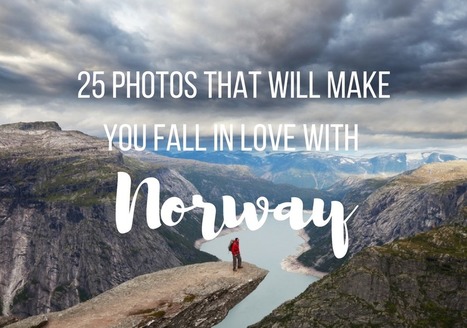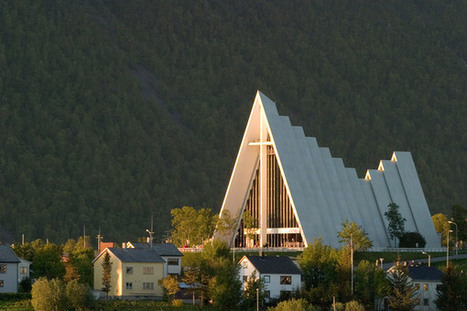"So how gorgeous is Norway? From its majestic wildlife, captivating Northern Lights shows, and snowy mountains, to its vivid landscapes, and mystifying fjords, Norway is a must-visit destination for anyone who loves the outdoors. Plus, opportunities for hiking, kayaking, glacier climbing, fishing, and skiing are endless! If Noway wasn’t already on your travel bucket list, I bet it is now!"
Get Started for FREE
Sign up with Facebook Sign up with X
I don't have a Facebook or a X account
 Your new post is loading... Your new post is loading...
 Your new post is loading... Your new post is loading...
Lena Minassian's curator insight,
February 18, 2015 7:17 PM
This articles discusses which countries use the most electricity and believe it or not, the Nordic countries are at the top of the list. It shows two satellite images in the nighttime for you to get a better visual as to which areas of these countries use the most electricity. There are multiple factors that go into these countries consuming this much energy. One factor that is interesting is the high demand for electricity because of the long winters in these countries. 
Kevin Cournoyer's curator insight,
May 6, 2015 9:34 AM
These images are really interesting and expose just how much electricity the Scandinavian countries actually use. It is surprising to think of these nations as large energy consumers because of their general reputation as progressive, clean, and liberal places. This brief article is an excellent example of how maps and satellite images can be misleading, though. As opposed to places like the U.S. or China, energy consumption in the Scandinavian countries actually produces only small amounts of greenhouse gases and is based on renewable energy sources.
This shows an interesting and not immediately apparent geographic distinction between the Scandinavian countries and places such as China and the U.S. Chinese and United States energy consumption is enormous because of those countries' ability and desire to produce large amounts of goods quickly. Household energy use is also high because of the widespread use of electronics such as televisions, computers, and appliances. The Scandinavian countries, on the other hand, have a need for increased energy use because of their geographic location: long, dark winters mean an increased need for electricity and for longer periods. Also, Scandinavia is able to produce energy at lower costs due to its use of renewable energy sources. So though those countries may consume much more energy than their non-Scandinavian counterparts, they are doing so responsibly and for a reason.
Katie Kershaw's curator insight,
February 22, 2018 11:41 AM
This map of Scandinavian energy usage holds a lot of insight to what this region of the world is like. Shockingly, Scandinavians all use more electricity per person per hour than the U.S. The people in Iceland use the most electricity of any other country and they use more than double the next closest consumer, at 52,374 kw/hour. This made me scratch my head a bit at first, because when I think of large energy consumers I think of Americans with huge t.v.s with surround sound, central air, and more useless kitchen appliances than anywhere else. However, the article goes on to explain the conditions that contribute to Scandinavians high power usage. First of all, they are located in a region with a very harsh climate. They must use tons of electricity to heat their buildings. Additionally the months of darkness in some regions require lights to be in constant use. Another regional factor that leads to high electricity usage is manufacturing. Since the region is abundant in natural resources like aluminum, a lot of electricity is needed to turn these resources into usable goods. The natural resources in Scandanavia also keeps electricity prices cheap, so people are more likely to use high amounts. Despite the high electricity usage by Scandanavians make minimal pollution because the sources of power they use are renewable resources. This makes sense because these countries are able to harness a lot of hydropower with their access to the ocean and waterfalls.
|
David Stiger's curator insight,
September 28, 2018 2:09 PM
Being raised Lutheran in the Mid-West, with Norwegian heritage, I can recall my relatives telling me that, unlike America, the "official church" of the Scandinavian countries is usually Lutheran. As a teen, it was always ironic to hear how irreligious, agnostic, and secular these European countries were despite having a state-sponsored religion. It's interesting to note that in 2012, the Lutheran church ceased to be the official national church of Norway - marking a trend that continues to grow.
Interestingly enough, despite Europe's decline of Christianity, many of these states support robust welfare systems and social programs that include the powerless and vulnerable. What does this reality say about Christianity then? Can the message of Jesus - to love and serve the downtrodden - be better achieved without Jesus the divine? Notably, Europe is the most advanced and developed region in the world and they are now the most secular region in the world. Perhaps the decrease in religiosity and traditional beliefs is tied to education, higher quality of life, technology, and better opportunity. It would be interesting to compare the most religious countries in the world (often Arab-Muslim and Latin American Roman Catholic) to determine if development has a strong correlation with declining religious participation. 
Olivia Campanella's curator insight,
October 1, 2018 4:19 PM
Europe is one of the most developed regions in the world and is also the most secular region today. Christianity was spreading across the globe but now, it is becoming part of Europe's past. In this article a Norwegian church attempted to help people check their enrollment or to sign up by creating a website, but, to their surprise 10,854 people clicked the unenroll option leaving the church with a net loss of 14,500 people.
Stevie-Rae Wood's curator insight,
October 28, 2018 3:15 PM
Europe today lacks the religious aspect it once held so close. Attendance of church has dramatically declined as time went on leaving many church buildings abandoned. Europe stands today as one of the most developed regions in the world however, it is now the most secular region today. Which is very different from how Europe use to be. Christianity is now becoming part of Europe's past. In this article a Norwegian church tries to combat the lack of church attendance and practices. They do this in a very modern way that being using the internet. They attempted to create an website where people could sign up or check their enrollment in church. However, this modern idea backfired and the church lost around 14,500 people as they clicked the un-enroll option on the website. I believe this idea failed because people that attend church probably lean more towards old traditions. So they might have felt insulted by the church that they had to enroll on a modern (new tradition). The members probably wanted the church to remain untouched by modernity.
|















My wife lived in Norway for 18 months, and her love for this country is infectious. The stunning physical geography leads to some equally magnificent cultural landscapes that were forged in a very rugged, inhospitable environment for early human settlers.
Tags: Norway, place, tourism, physical, Arctic, geo-inspiration, images, art, landscape.